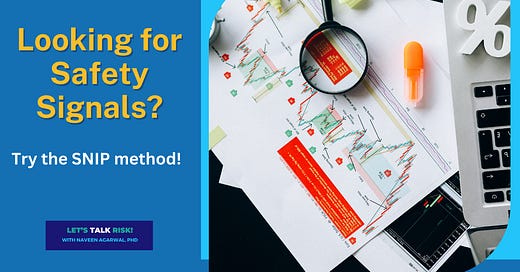SNIP Your Way Through Noise to Confidently Detect Safety Signals
An easy way to evaluate emerging safety signals for your medical device. Learn about it and other techniques for post-market surveillance in a 4h hands-on workshop.
Looking for a credible safety signal can be like looking for a needle in a haystack!
This is because post-market surveillance data for medical device is very noisy, and traditional methods of analysis are not capable of finding rare, but potentially serious signals.
Trend analysis is a commonly used method to detect potential safety signals in post-market surveillance data for a medical device.
Other, more sophisticated, statistical analysis methods such as ARIMA time series and Proportional Reporting Ratio (PRR) are also used in the industry for signal detection.
Frequently, these methods flag signals that may be just noise and not true signals representing a serious issue needing immediate attention. On the other hand, they lack the power to flag a true signal based on a single event that may indeed be a serious issue for patient safety.
There is a need, therefore, to develop a method to assess each signal flagged by statistical analysis to decide if it warrants further investigation. In other words, we need a method to confirm potential signals and to make decisions about further action.
SNIP - a highly effective framework for signal evaluation
SNIP is an acronym for for Strength of Association, Newness of the Event, Importance of the Event, and Potential for Prevention.
Here is an excerpt from our Post-Market Surveillance Workshop, where we review this method in detail and practice its application to a case study scenario.
In this method, each signal is evaluated along the 4 dimensions of SNIP using qualitative ratings based on subject matter expertise. Finally, an overall rating is assigned based on pre-determined rules to drive action.
As an example, if a potential signal is high on S and I, then we may decide to act even though we may not have sufficient information to decide whether it is preventable or not.
Alternately, if a potential signal is not high on S, but new and medically important, we may decide to not act immediately and closely monitor it for some time.
The SNIP method is intuitive and easy to explain. It can help you justify a rationale for taking no action even when a potential signal is triggered based on statistical thresholds.
Here are the 5 learning objectives of the post-market surveillance workshop
Understand regulatory requirements for post-market surveillance - FDA, EU-MDR, ISO 13485, ISO 14971
Learn about data sources and analysis methods
Learn how to detect and evaluate safety signals
Learn when and how to update the risk management file
Learn how to set up an efficient operating model for post-market surveillance.
Sign up to boost your knowledge of post-market surveillance
Space is limited to only 10 attendees in each session.






